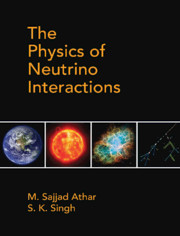Book contents
- Frontmatter
- Dedication
- Contents
- List of Figures
- List of Tables
- Preface
- Acknowledgments
- Chapter 1 Neutrino Properties and Its Interactions
- Chapter 2 Relativistic Particles and Neutrinos
- Chapter 3 Quantization of Free Particle Fields
- Chapter 4 Interacting Fields and Relativistic Perturbation Theory
- Chapter 5 Phenomenological Theory I: Nuclear β-decays and Weak Interaction of Leptons
- Chapter 6 Phenomenological Theory II: Weak Decays of Hadrons
- Chapter 7 Gauge Field Theories and Fundamental Interactions
- Chapter 8 Unified Theory of Electroweak Interactions
- Chapter 9 Neutrino and Electron Scattering from Point Particles
- Chapter 10 Neutrino scattering Cross Sections from Hadrons: Quasielastic Scattering
- Chapter 11 Neutrino Scattering from Hadrons: Inelastic Scattering (I)
- Chapter 12 Neutrino Scattering from Hadrons: Inelastic Scattering (II)
- Chapter 13 Neutrino Scattering from Hadrons: Deep Inelastic Scattering
- Chapter 14 Weak Quasielastic v(⊽)-nucleus Scattering
- Chapter 15 Inelastic Scattering of (Anti)neutrinos from Nuclei
- Chapter 16 Deep Inelastic Scattering of (Anti)neutrinos from Nuclei
- Chapter 17 Neutrino Sources and Detection of Neutrinos
- Chapter 18 Neutrino Mixing and Oscillations
- Chapter 19 Neutrino Astrophysics and the Synthesis of Elements
- Chapter 20 Neutrino Interactions Beyond the Standard Model
- Appendices
- Appendix A Lorentz Transformation and Covariance of the Dirac Equation
- Appendix B Cabibbo Theory
- Appendix C Some Properties of Pauli and Dirac Matrices and Spin Density Matrices
- Appendix D Leptonic and Hadronic Tensors
- Appendix E General Expression for the Total Scattering Cross Section and Decay Rates
- Appendix F Expressions of N(q2), the Coefficients of the Polarization Observables
- References
- Index
Chapter 8 - Unified Theory of Electroweak Interactions
Published online by Cambridge University Press: 22 May 2020
- Frontmatter
- Dedication
- Contents
- List of Figures
- List of Tables
- Preface
- Acknowledgments
- Chapter 1 Neutrino Properties and Its Interactions
- Chapter 2 Relativistic Particles and Neutrinos
- Chapter 3 Quantization of Free Particle Fields
- Chapter 4 Interacting Fields and Relativistic Perturbation Theory
- Chapter 5 Phenomenological Theory I: Nuclear β-decays and Weak Interaction of Leptons
- Chapter 6 Phenomenological Theory II: Weak Decays of Hadrons
- Chapter 7 Gauge Field Theories and Fundamental Interactions
- Chapter 8 Unified Theory of Electroweak Interactions
- Chapter 9 Neutrino and Electron Scattering from Point Particles
- Chapter 10 Neutrino scattering Cross Sections from Hadrons: Quasielastic Scattering
- Chapter 11 Neutrino Scattering from Hadrons: Inelastic Scattering (I)
- Chapter 12 Neutrino Scattering from Hadrons: Inelastic Scattering (II)
- Chapter 13 Neutrino Scattering from Hadrons: Deep Inelastic Scattering
- Chapter 14 Weak Quasielastic v(⊽)-nucleus Scattering
- Chapter 15 Inelastic Scattering of (Anti)neutrinos from Nuclei
- Chapter 16 Deep Inelastic Scattering of (Anti)neutrinos from Nuclei
- Chapter 17 Neutrino Sources and Detection of Neutrinos
- Chapter 18 Neutrino Mixing and Oscillations
- Chapter 19 Neutrino Astrophysics and the Synthesis of Elements
- Chapter 20 Neutrino Interactions Beyond the Standard Model
- Appendices
- Appendix A Lorentz Transformation and Covariance of the Dirac Equation
- Appendix B Cabibbo Theory
- Appendix C Some Properties of Pauli and Dirac Matrices and Spin Density Matrices
- Appendix D Leptonic and Hadronic Tensors
- Appendix E General Expression for the Total Scattering Cross Section and Decay Rates
- Appendix F Expressions of N(q2), the Coefficients of the Polarization Observables
- References
- Index
Summary
The unified theory of weak and electromagnetic interactions was formulatedindependently by Weinberg [157] and Salam [37] for leptons. It was laterextended to the quark sector using the GIM mechanism of quark mixingproposed by Glashow, Iliopoulos, and Maiani (GIM) [64]. The theory ispopularly known as the “standard model of electroweakinteractions”. (ii) L. Glashow, A. Salam, and S. Weinberg wereawarded the Nobel Prize in Physics in 1979 for the formulation of thistheory. In this chapter, we describe the formulation of the standard modelfor leptons and quarks and its applications to other interactions. Thepredictions of the model and their experimental confirmations are alsopresented. The limitations of the model and some processes suggesting theneed for the physics beyond the standard model are discussed later inChapter 20.
In this section, the essential features of the electromagnetic interactionsand the phenomenological V – Atheory of electroweak interactions, well-known from the experimental andtheoretical studies of the various weak processes are summarized. They areused as inputs in formulating the standard model. They are as follows:
1. Both electromagnetic and weak interactions involve, in general,all the elementary particles, that is, leptons and quarks, unlikethe strong interaction, which affect only the quarks and the hadronsbuilt from these quarks.
2. Both electromagnetic and weak interactions are mediated by vectorfields. Electromagnetic interaction is known to be mediated byphotons described by the electromagnetic fieldAμ, which is massless.The observed weak interactions are presumed to be mediated bycharged intermediate vector bosons (IVB), Which are massive withmass MW.
3. Weak interactions involve a pair of leptons, like in which thecharged vector bosons, interact with the charged lepton currents,where only the left-handed leptons participate, that is,right-handed leptons, that is, are not involved in the interaction.The interaction Lagrangian is written as:
4. Electromagnetic interactions involve the electromagnetic fieldAm, which interacts with the electromagneticcurrent, implying that both the left- and the righthanded componentsof the electron participate, because The interaction Lagrangian iswritten as:
5. Both electromagnetic and weak interactions are universalinteractions, that is, they have the same coupling strength forleptons and quarks. However, the coupling strengths of theelectromagnetic and weak interactions to the quarks (leptons) aredifferent from each other.
- Type
- Chapter
- Information
- The Physics of Neutrino Interactions , pp. 318 - 361Publisher: Cambridge University PressPrint publication year: 2020



